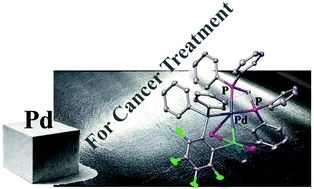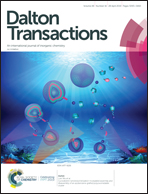Synthesis, anti-proliferative and apoptosis-inducing studies of palladacycles containing a diphosphine and a Sn,As-based chelate ligand†
Abstract
Cleavage of the bromide bridges in [Pd2(μ-Br)2{κ2(Sn,As)-2-MeBrSnC6F4AsPh2}2] (1) by diphosphine ligands gave the mono- and dinuclear palladacycles [Pd(L)Br{κ2(Sn,As)-2-MeBrSnC6F4AsPh2}] [L = dppe (2) dppm (3), ortho-dppBz (4)] and [Pd2Br2(para-dppBz){κ2(Sn,As)-2-MeBrSnC6F4AsPh2}2] (5). The interactions of these complexes with DNA (CT-DNA) and proteins (human serum albumin) were studied by UV-Vis and fluorescence spectroscopy, respectively. The results confirmed the interaction of these palladium complexes with CT-DNA through groove binding, and their strong binding affinity to HSA. The anti-proliferative activities of complexes 1–5 were tested against four human cancer cell lines (HeLa, A549, PC-3, and HT1080) and normal keratinocytes (HaCaT). Among the series, the palladium(II) complex containing the 1,2-bis(diphenylphosphino)benzene ligand (4) showed the highest cytotoxicity against HeLa, PC-3 and HT1080 cells, with IC50 values of 0.25 ± 0.08, 0.85 ± 0.11, and 0.66 ± 0.15 μM, respectively. Interestingly, compound 4 exhibited lower cytotoxic activity toward normal HaCaT cells (IC50 = 4.65 ± 0.16 μM). Additionally, this complex exhibited lower toxicity and better anti-cancer activity than cisplatin. Further mechanistic studies, including Hoechst staining and flow cytometry, confirmed that complex 4 induced G2/M phase cell cycle arrest and apoptotic cell death in HeLa cells.



 Please wait while we load your content...
Please wait while we load your content...